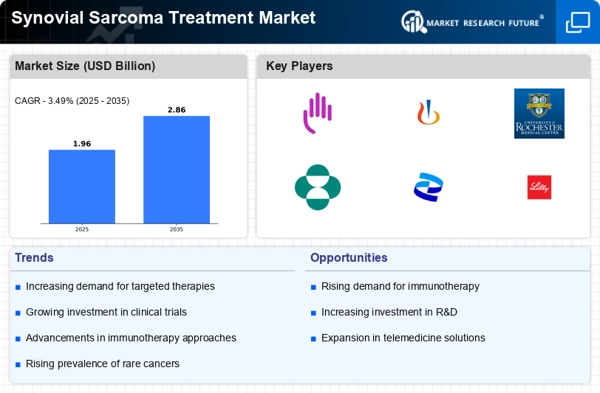The Synovial Sarcoma Treatment Market is characterized by a complex interplay of competitive dynamics, driven by a combination of innovation, strategic partnerships, and regional expansion. Key players such as Bristol Myers Squibb (US), Novartis (CH), and Roche (CH) are at the forefront, each adopting distinct operational focuses that shape the market landscape. Bristol Myers Squibb (US) emphasizes its commitment to research and development, particularly in immunotherapy, which appears to be a promising avenue for treating rare cancers like synovial sarcoma. Meanwhile, Novartis (CH) has been actively pursuing mergers and acquisitions to bolster its oncology portfolio, indicating a strategy aimed at enhancing its therapeutic offerings. Roche (CH), on the other hand, is focusing on precision medicine, leveraging its expertise in diagnostics to tailor treatments more effectively to patient needs. Collectively, these strategies contribute to a competitive environment that is increasingly centered around innovation and patient-centric approaches.
In terms of business tactics, companies are increasingly localizing manufacturing and optimizing supply chains to enhance efficiency and responsiveness to market demands. The competitive structure of the Synovial Sarcoma Treatment Market appears moderately fragmented, with several key players exerting influence while also facing competition from emerging biotech firms. This fragmentation allows for a diverse range of treatment options, although it also necessitates strategic collaborations among established companies to maintain market share and drive growth.
In August 2025, Merck & Co (US) announced a strategic partnership with a leading biotech firm to co-develop a novel therapy specifically targeting synovial sarcoma. This collaboration is significant as it not only expands Merck's oncology pipeline but also underscores the importance of partnerships in accelerating drug development processes. The synergy between the two companies may lead to innovative treatment solutions that could enhance patient outcomes in this challenging therapeutic area.
In September 2025, Pfizer (US) launched a new clinical trial for a targeted therapy aimed at synovial sarcoma, which is expected to provide insights into the efficacy of its treatment approach. This move reflects Pfizer's ongoing commitment to advancing cancer therapies and highlights the company's strategy of investing in clinical research to address unmet medical needs. The outcomes of this trial could potentially position Pfizer as a leader in the treatment of this rare cancer, further solidifying its market presence.
In October 2025, Eli Lilly and Company (US) unveiled a digital health initiative aimed at improving patient engagement and adherence to treatment protocols for synovial sarcoma patients. This initiative is indicative of a broader trend towards digitalization in healthcare, where technology is leveraged to enhance patient experiences and outcomes. By integrating digital tools into its treatment framework, Eli Lilly may not only improve patient adherence but also gather valuable data to inform future therapeutic developments.
As of October 2025, the competitive landscape in the Synovial Sarcoma Treatment Market is increasingly defined by trends such as digitalization, sustainability, and the integration of artificial intelligence in drug development. Strategic alliances are becoming more prevalent, as companies recognize the need to collaborate to innovate effectively. Looking ahead, it is likely that competitive differentiation will evolve from traditional price-based strategies to a focus on innovation, technological advancements, and the reliability of supply chains. This shift may ultimately lead to more effective and personalized treatment options for patients, thereby enhancing overall market dynamics.


















Leave a Comment